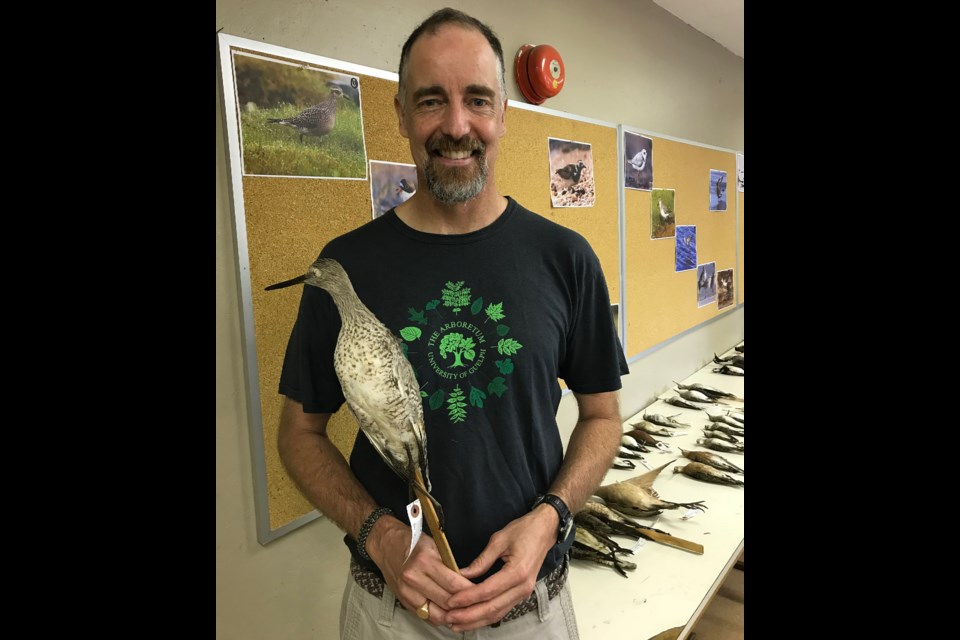It is one of the most difficult groups of birds to identify.
But recently, a group of eager nature enthusiasts were up for the challenge to take a closer look at identifying ‘shorebirds’ at a workshop held at the Arboretum in Guelph.
“The motto for today is, “I don’t know” said Arboretum naturalist, Chris Earley.
“Shorebirds are a super tough group. When you get out in the field, you’ll say to yourself, I don’t know why, but that’s important. This is definitely not one of those things that everyone knows about.”
Earley graduated with a Bachelor of Science in zoology and has a master’s degree in environmental biology from the University of Guelph.
He is the Arboretum’s interpretive biologist and education coordinator, a natural history author and a veteran international expedition leader.
“There are 400 acres here, lots of educational programming and this is one of eight bird workshops we offer,” he said.
And for Earley, identifying sandpipers, plovers, phalaropes, turnstones, knots, godwits and whimbrels, has become second nature.
Growing up in Strathroy, Earley would bike down to the sewage lagoons and begin looking at the various shapes of shorebirds.
“The focus here is on shapes. Every other workshop focuses on field marks,” he told a group, some avid attendees of workshops at the Arboretum and some just enthusiastic amateurs from all over including Brantford, Mississauga and Guelph.
Along with noticing the shapes of birds, size, plumage, calls and behaviour are also key when identifying shorebirds.
“Size is very important, and the good thing is, you can usually see them right out in the open. You can get a good profile walking along the shore,” Earley said.
But size and shape can be tricky to identify, which is why Earley suggests using binoculars as the birds might often seem larger than they really are.
“Long skinny legs and probing type beaks…that’s usually what we’re looking for,” Earley said.
“Anatomy beginning with the beak is super important. The length, the shape, seeing if it’s down curled, up curled or straight. The tip of the beak is one of the most important things to look at.”
Earley says legs are also something to recognize. Legs are usually long and skinny but there are different leg sizes. Colour is also something to notice because mud and depth of water can change colour and visibility.
‘Plus, people have different perceptions of colour. There is a difference in how people see colours,” he said.
Facial features including markings and eye line patterns are also integral in distinguishing shorebirds, as well as their plumage which differs from season to season for each species.
Earley shows various study skins, preserved dead birds that have been kept as educational specimens – some from the 1950’s and even from as early as 1935.
“Ah, the American golden plover. These are just gorgeous birds. They are colourful and look at the smaller beak,” Earley says.
“Most breed in the Arctic. There are so many shorebirds all along the tundra. It’s a great shorebird experience if you get the chance.”
Earley would know, being a veteran international expedition leader.
In December, He will be leading U of G’’s Worldwide Quest Alumni Expeditions, “Ultimate Antarctica Expedition” which will also include the Weddell Sea and the Falkland Islands.
Visits to penguin and sea colonies, cruising alongside the legendary albatross and watching massive icebergs are all part of the package.
During his presentation, a picture of the piping plover appears.
“You can often see them at Sauble Beach,” Earley said. “They are endangered but doing much better than decades ago. You can find them on sandy beaches and that’s where they nest. But people use sandy beaches so there are big conflicts.”
For many, the killdeer is probably the most widely known. It performs the common, “broken wing” display.
“This is the gateway bird into shorebirding,” Earley says.
Killdeer like to nest on open ground, particularly on gravel.
And the oyster catcher always seems to be a common favorite.
“They have great big orange beaks and long legs,” Earley said.
“What makes all shorebirds so amazing is that they eat different things in the same habitat and in different ways.”
The solitary sandpiper is particularly interesting because they nest in trees according to Earley.
“And it’s always important to remember that shorebirds are usually hunched,” he says. “When alert, they are upright. So, their mood and their shape can easily change.”
Flight patterns for different species vary and another key observation is that most female and male species in shorebirds look very much the same.
Participants were on the ready throughout the day long workshop, with their guide to shorebirds on hand.
For over 20 years, the University of Guelph’s Arboretum has been providing workshops for adults and professionals.
By attending the workshops, participants help support the educational activities at the arboretum.
From June through to September, a variety of workshops are being offered from mushrooms, moths and shrub identification.
“There’s so many things to learn and each year there is something different,” says Sally Cheung, a wildlife biology and conservation graduate from the U of G and a second-year naturalist intern at the Arboretum.
“I just went to the workshop on shrub identification and I thought I knew so much but there’s really so much more to learn,” Cheung said.
“And being at the Arboretum, it really is a beautiful place to be.”
Coming soon at the Arboretum: owls, gulls, animal tracking, reptiles, pruning and spring flowers.
For more information, visit: www.uoguelpg.ca/arboretum.



